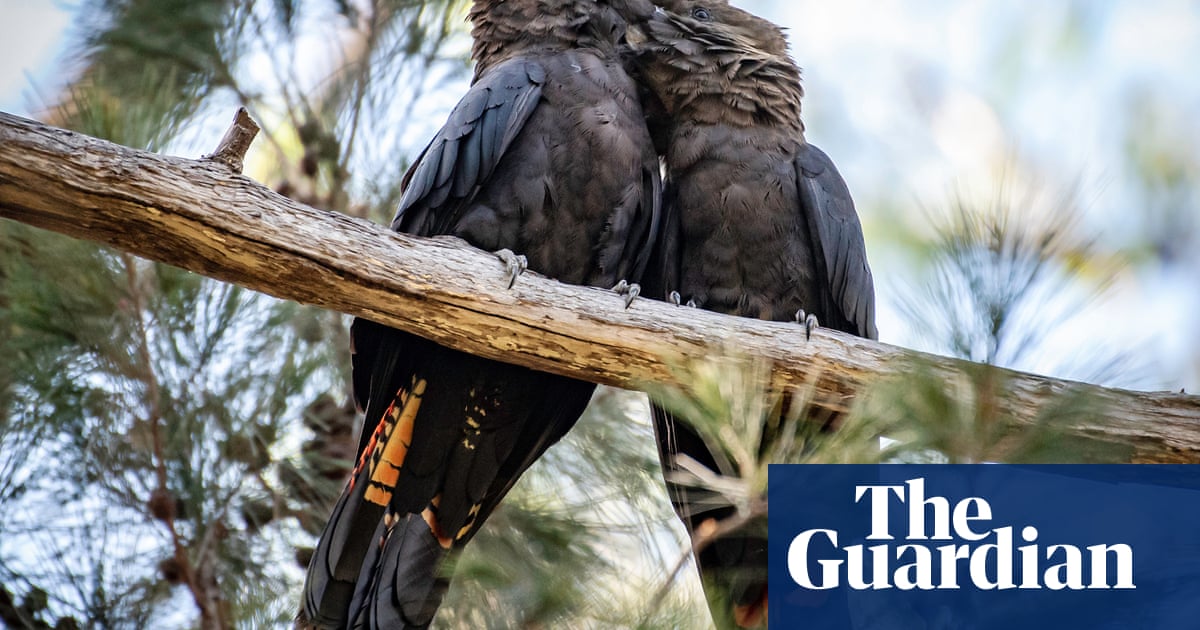Glossy black cockatoos could be pushed towards extinction inVictoriaif planned burns of 13,000 hectares of forest go ahead, ecologists and conservationists warn.
The Victorian government is being urged to abandon the burn, which is intended to reduce bushfire risk.
Glossy black cockatoos are listed as vulnerable in Victoria, where they are found only in East Gippsland.
Nearly two-thirds (64%) oftheir Victorian habitatwas burned in the 2019-20 black summer bushfires, leaving the speciesalmost entirely dependent on 48,000 hectares of unburnt coastal forest between Lake Tyers and Orbost, about 350km east of Melbourne.
A peer-reviewed study published in the journal Australian Field Ornithology estimated that the Victorian population had declined by three-quarters since the fires.
Glossy black cockatoos feed almost exclusively on the cones of black sheoak trees.
Peter Menkhorst, a retired ecologist who worked for Victorian government wildlife agencies for 48 years and a co-author of the study, said they probably had the most specialised diet of any Australian bird, and thata fire in black sheoak forests could badly damage their food supply. He said any unburnt stands of black sheoak were “of critical importance for the species”.
A state government report intobiodiversity after the firesagreed that surviving black sheoak stands were of “great significance for this highly specialised bird species” and advised “great care” would be needed in managing the forests.
Sign up for Guardian Australia’s breaking news email
But conservation groups have expressed concern that the state’s forest fire management department plans to burn what they estimate is 13,000 hectares of the bird’s remaining habitat over the next three years.
Gippsland Environment Group and the Victorian National Parks Association say the birds may never recover if the burns go ahead.
Louise Crisp, a founding member of the Gippsland organisation, said she was “horrified” that significant sheoak stands near Lake Tyers and Lakes Entrance were burned.
“What they’re doing is burning the glossies’ pantry,” she said.
Even a low-intensity fire could cause the cones to open and shed their seed, she said, which was a problem because the birds wouldn’t eat seed from the ground.
“My biggest fear is that the population will not have a chance to recover from the incredible effects of the black summer bushfires because Forest Fire Management Victoria are continuing to burn their sole food resource.”
Sign up toBreaking News Australia
Get the most important news as it breaks
after newsletter promotion
A spokesperson for Forest Fire Management Victoria said uncontrollable fire was the greatest threat to cockatoo feeding habitat and low-intensity planned burns helped reduce fuel loads and protect sheoak trees.
“Ensuring the protection of native wildlife and habitat in the short and long term is a key priority when implementing our planned burning program,” they said.
Dr Daniella Teixeira, an ecologist who researches glossy black cockatoos at Queensland University of Technology and is chairing a species recovery team, said fires in sheoaks needed to be planned carefully to avoid areas where the birds were feeding, particularly if there were nest sites nearby. Fire that was too hot could kill the trees.
The birds were “very fussy” about what they ate, she said, “even down to the individual trees”.
Teixeira said the species was long-lived and slow to reproduce, laying a single egg every one or two years, and in decline across its range.
BirdLife Australia’s president, Mandy Bamford, said Victoria’s glossy black cockatoo population was “tiny”, estimated at 250 birds. Those birds needed sheoaks to feed on and safe places to nest, she said, and BirdLife had worked with the department to map priority sites that needed protection.
The department’s preferred burn window in autumn posed an additional risk, she said, as it overlapped with the bird’s breeding season. “If there are nestlings in hollows, they can’t get away. Also, potentially you’re reducing food sources at a critical time when they’re feeding chicks.”
Concerns have been raised about Forest Fire Management Victoria activities after an endangeredgreater gliderwas found dead next to a tree-felling operation in Yarra Ranges national park in May 2024. Acritically endangered orchidreceived a last-minute reprieve from a planned burn last October after a local environment group threatened legal action to protect its habitat.
Jordan Crook, a nature campaigner at the Victorian National Parks Association, said authorities had a duty to protect threatened species along with houses and infrastructure. He said fire management planning was happening “behind closed doors” without independent oversight.
“We need to fundamentally change how we use fire in the landscape and manage bushfires,” he said. “The way we’re currently doing it is damaging our biodiversity and our wildlife habitat.”
